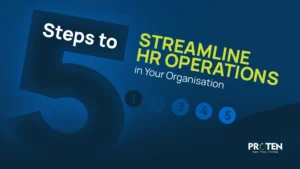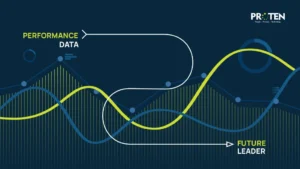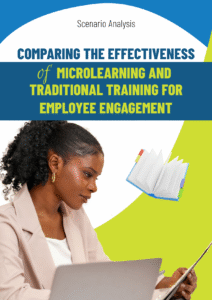Performance reviews are a fundamental aspect of your organization. They serve as a crucial tool for evaluating your employees’ performances, providing feedback, and setting goals for the future.
Effective year-end performance reviews are not only essential for individual employee development but also for the overall success of your company. They provide a valuable opportunity to recognize and reward top performers, identify areas for improvement, and ensure that employees are aligned with the company’s goals by supercharging their morale.
However, conducting effective performance reviews can be challenging. Many managers struggle with setting clear expectations, providing constructive feedback, and avoiding biases.
Additionally, the time-consuming nature of the review process can make it difficult to prioritize and allocate sufficient resources.
To address these challenges, it’s important to adopt a systematic and strategic approach to performance reviews. Below, we’ll explore ten such strategies that can help you conduct meaningful and impactful year-end performance reviews.
By implementing the ten strategies outlined in this article, you can create a more effective and meaningful review process that benefits both your employees and the organization.
Strategy 1: Set Clear Objectives
The foundation of any successful performance review lies in clear and measurable objectives. Before the review process begins, ensure that both you and your employee are aligned on the employee’s key responsibilities and expectations. These objectives should be specific, measurable, achievable, relevant, and time-bound. Or SMART, for short.
- Specificity: Avoid vague or ambiguous statements. Clearly define what is expected, using concrete terms and measurable criteria. For example, instead of saying “Improve customer satisfaction,” specify “Increase customer satisfaction ratings by 10% by the end of the year.”
- Measurability: Establish quantifiable benchmarks or metrics to track progress and assess achievement. This allows for objective evaluation and provides a clear sense of accomplishment.
- Achievability: Set challenging but realistic goals that motivate employees to strive for excellence. Avoid setting unattainable goals, as this can lead to frustration and disengagement.
- Relevance: Ensure that objectives are aligned with the employee’s role, the team’s goals, and your business’s overall strategy. This helps your employees understand how their work contributes to the bigger picture and motivates them to achieve their goals.
- Time-bound: Set deadlines for achieving each objective. This creates a sense of urgency and helps employees stay focused and accountable.
Strategy 2: Use Data-Driven Assessments
To provide accurate and fair feedback, it’s crucial to base your assessment on concrete data. This can include metrics such as sales figures, project outcomes, team performance, or a properly developed OKR. By using data, you can avoid subjectivity and ensure that your evaluation is grounded in facts.
Here’s how to use data-driven assessments effectively:
- Identify relevant metrics: Determine which metrics are most relevant to the employee’s role and the organization’s goals. This will help you focus on the data that matters most.
- Collect and analyze data: Gather data from various sources, such as sales reports, project management tools, customer surveys, and performance reviews. Analyze the data to identify trends, patterns, and areas for improvement.
- Use data to support your feedback: Use the data you’ve collected to support your feedback and provide specific examples of the employee’s performance. This helps employees understand the reasons behind your assessment and makes it more credible.
- Avoid relying solely on data: While data is important, it’s not the only factor to consider. Qualitative factors, such as teamwork, communication skills, and problem-solving abilities, should also be taken into account.
- Use data to set goals: Use data to identify areas where the employee can improve and set specific, measurable goals for the next year. This helps employees understand their development needs and stay motivated.
By using data-driven assessments, you can provide more objective, fair, and actionable feedback, which can help employees improve their performance and contribute more effectively to the organization.
Strategy 3: Incorporate 360-degree Feedback
While manager feedback is essential, it’s also valuable to gather input from other stakeholders. 360-degree feedback involves collecting feedback from peers, subordinates, and superiors. This can provide a more comprehensive and balanced perspective on the employee’s performance.
Here’s how to incorporate 360-degree feedback effectively:
- Choose the right participants: Identify the individuals who can provide the most valuable feedback. This may include peers, direct reports, supervisors, or external customers.
- Develop a feedback questionnaire: Create a questionnaire that asks specific questions about the employee’s performance, strengths, and areas for improvement.
- Ensure anonymity: Assure participants that their feedback will be kept confidential. This can encourage them to be honest and open.
- Collect and analyze feedback: Gather feedback from all participants and analyze the results to identify common themes and areas for improvement.
- Provide feedback to the employee: Share the feedback with the employee, focusing on the areas where there is general agreement. Avoid sharing individual comments that may be harmful or unfair.
- Use feedback for development: Work with the employee to develop an action plan based on the feedback. This can help them identify areas for improvement and set goals for the future.
By incorporating 360-degree feedback into your performance reviews, you can gain a more complete and accurate picture of the employee’s performance, identify areas for development, and foster a more collaborative and supportive work environment.
Strategy 4: Provide Continuous Feedback
One of the most effective ways to improve employee performance is to provide ongoing feedback throughout the year. Instead of waiting for the annual performance review, offer regular feedback on the employee’s progress, achievements, and areas for improvement. This helps employees stay on track, address issues promptly, and recognize their contributions.
Continuous feedback can be delivered in various ways, like one-on-one meetings, informal conversations, email, or instant messaging. The key is to make it a regular part of your communication with employees. When providing feedback, be specific, constructive, and supportive. Focus on the employee’s behavior or actions, rather than their personal qualities. Offer suggestions for improvement and provide resources or coaching if needed.
By providing continuous feedback, you can foster a more open and collaborative work environment, build trust with your employees, and help them reach their full potential. Remember, the goal of feedback is to help employees improve, not to criticize or punish.
Strategy 5: Align Reviews with Company Goals
To ensure that performance reviews are aligned with the organization’s overall objectives, it’s important to tie employee goals to the company’s strategic priorities. This helps employees understand how their work contributes to the bigger picture and motivates them to achieve their goals.
Here’s how to align reviews with company goals:
- Communicate company goals: Clearly communicate the organization’s mission, vision, and strategic objectives to all employees. This helps them understand how their work fits into the broader context.
- Link employee goals to company goals: Work with employees to set goals that are aligned with the company’s strategic priorities. This helps employees see how their work contributes to the organization’s success.
- Provide opportunities for development: Offer employees opportunities for professional development that support the company’s goals. This can include training programs, mentorship, or job rotations.
- Recognize and reward alignment: Recognize and reward employees who demonstrate a strong commitment to the company’s goals. This can help motivate employees to continue striving for excellence.
By aligning performance reviews with company goals, you can create a more engaged and motivated workforce, improve employee retention, and drive organizational success.
Strategy 6: Train Managers Effectively
Effective performance reviews require effective managers. Providing managers with training on performance review techniques, active listening skills, and constructive feedback can help them conduct more meaningful and impactful conversations with their employees.
Manager training should cover a variety of topics, including:
- Performance review best practices: Managers should learn about the key elements of a successful performance review, such as setting clear objectives, using data-driven assessments, and providing constructive feedback.
- Active listening skills: Effective managers need to be able to actively listen to their employees’ concerns and feedback. This involves paying attention, asking clarifying questions, and showing empathy.
- Constructive feedback techniques: Managers should learn how to provide feedback that is specific, actionable, and supportive. This involves focusing on the employee’s behavior or actions, rather than their personal qualities, and offering suggestions for improvement.
- Coaching and mentoring skills: Managers should be equipped to coach and mentor their employees, helping them to develop their skills and reach their full potential.
- Handling difficult conversations: Managers should be prepared to handle difficult conversations, such as addressing performance issues or discussing sensitive topics.
By investing in manager training, organizations can improve the quality of their performance reviews, enhance employee morale, and foster a more positive and productive work environment.
Strategy 7: Utilize Performance Management Software
Performance management software can significantly streamline the review process and provide valuable insights into employee performance. By automating many of the administrative tasks associated with performance reviews, such as scheduling, distributing forms, and collecting feedback, organizations can save time and resources. Additionally, this software can help ensure that reviews are conducted consistently and fairly across the organization.
Beyond administrative efficiency, performance management software can also offer a wealth of data and analytics. It can track employee goals, collect 360-degree feedback, and generate comprehensive reports that provide insights into performance trends, areas for improvement, and the effectiveness of development initiatives. This data can be used to make more informed decisions about employee development, compensation, and promotions.
Furthermore, performance management software can foster a more collaborative and transparent work environment. By providing a centralized platform for setting goals, providing feedback, and tracking progress, employees can have a clearer understanding of their expectations and how their work contributes to the organization’s success. This can increase employee engagement, motivation, and overall job satisfaction.
Strategy 8: Foster Open Communication.
Open and honest communication is essential for successful performance reviews. Creating a safe and supportive environment where employees feel comfortable sharing their thoughts and concerns is crucial. By encouraging open dialogue and active listening, managers can build trust and foster a positive working relationship.
To foster open communication, managers should strive to create a welcoming atmosphere where employees feel valued and respected. This involves modeling open communication, actively listening to employees’ concerns, and respecting their perspectives. Additionally, managers should regularly engage in open and honest conversations with employees, both in formal performance reviews and informal check-ins. This creates opportunities for employees to share their thoughts, ask questions, and provide feedback.
When providing feedback, it’s important to be specific, constructive, and supportive. Avoid criticizing or blaming employees, and focus on providing actionable guidance for improvement. By addressing concerns promptly and demonstrating a commitment to resolving issues, managers can further strengthen their relationship with employees and create a more positive work environment.
Strategy 9: Set Actionable Goals for Next Year
The year-end review should not be just a retrospective; it should also be a forward-looking exercise. Work with the employee to set clear and achievable goals for the next year. These goals should be aligned with the employee’s career aspirations and the organization’s strategic objectives.
When setting goals for the next year, it’s important to:
- Involve the employee: Work closely with the employee to identify their career aspirations and set goals that are meaningful and motivating.
- Align goals with company objectives: Ensure that the goals are aligned with the organization’s strategic priorities. This helps employees understand how their work contributes to the bigger picture.
- Make goals SMART: Ensure that goals are specific, measurable, achievable, relevant, and time-bound (SMART). This helps employees track progress and stay motivated.
- Create a development plan: Develop a plan to help the employee achieve their goals. This may include providing training, mentorship, or additional resources.
- Review and adjust goals: Regularly review and adjust goals as needed to ensure that they remain relevant and achievable.
By setting actionable goals for the next year, you can help employees develop their skills, advance their careers, and contribute more effectively to the organization’s success.
Strategy 10: Follow Up and Monitor Progress
After the review, it’s important to follow up with the employee to ensure that they understand their goals and are committed to achieving them. Regularly monitor their progress and provide support and guidance as needed. This ongoing support can help employees stay motivated and on track.
- Regular check-ins: Schedule regular check-ins with the employee to discuss their progress, address any challenges, and provide support and guidance.
- Provide resources and support: Offer the employee the resources and support they need to achieve their goals. This may include training, mentorship, or additional resources.
- Recognize and reward progress: Acknowledge and reward the employee’s progress toward their goals. This can help them stay motivated and continue striving for excellence.
- Adjust goals as needed: If the employee is facing challenges or the circumstances have changed, be willing to adjust their goals to ensure that they remain relevant and achievable.
- Provide ongoing feedback: Continue to provide ongoing feedback throughout the year to help the employee stay on track and address any issues promptly.
By following up with employees and monitoring their progress, you can ensure that performance reviews are not just a one-time event but an ongoing process that supports employee development and organizational success.
Conclusion…
Effective year-end performance reviews are essential for employee development, organizational success, and fostering a positive work environment. By implementing the ten strategies outlined in this article, you can conduct meaningful and impactful reviews that benefit both employees and the organization.
Remember, the goal of a performance review is not just to evaluate past performance but to set the stage for future success. By providing constructive feedback, setting clear goals, and offering support and guidance, you can help employees develop their skills, advance their careers, and contribute more effectively to the organization’s objectives.
In addition to the strategies discussed in this article, it’s also important to create a culture of performance excellence throughout the organization. This involves fostering a positive and supportive work environment, providing opportunities for professional development, and recognizing and rewarding employee achievements. By investing in employee development and creating a high-performance culture, organizations can achieve their strategic goals and build a sustainable competitive advantage.
Finally, it’s important to remember that performance reviews are a continuous process, not just a one-time event. By regularly evaluating employee performance, providing feedback, and setting goals, you can create a culture of ongoing improvement and growth. This will benefit both employees and the organization as a whole.










